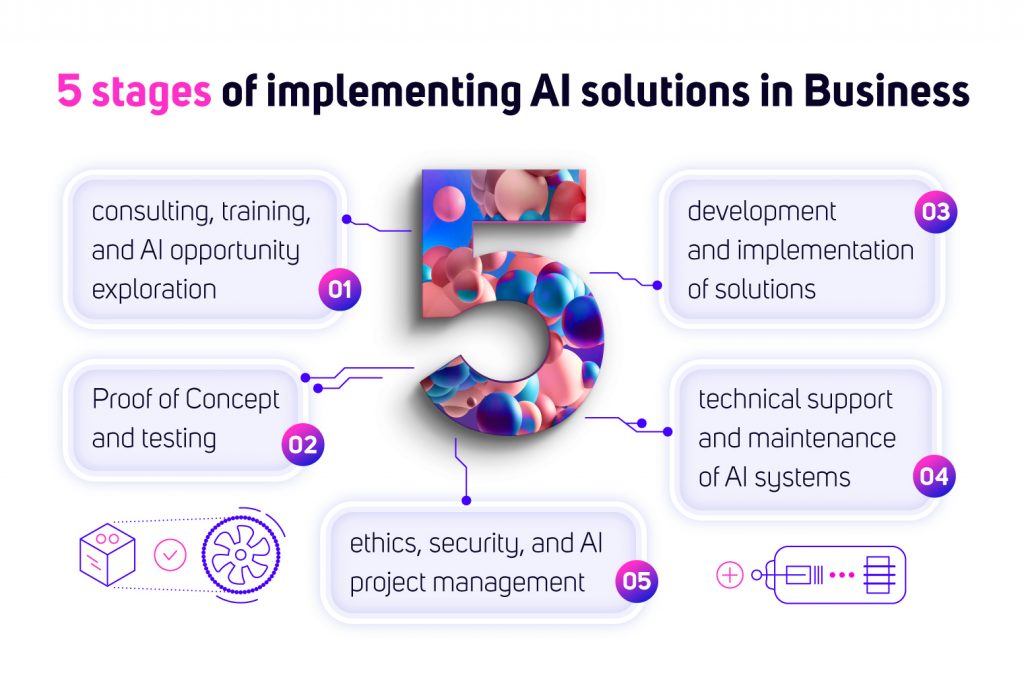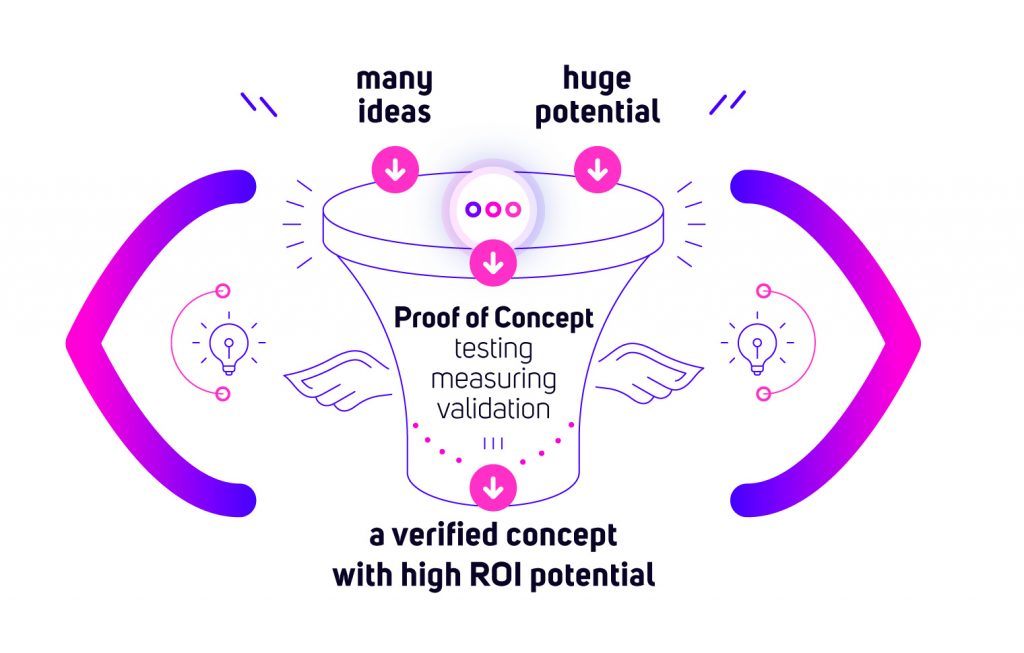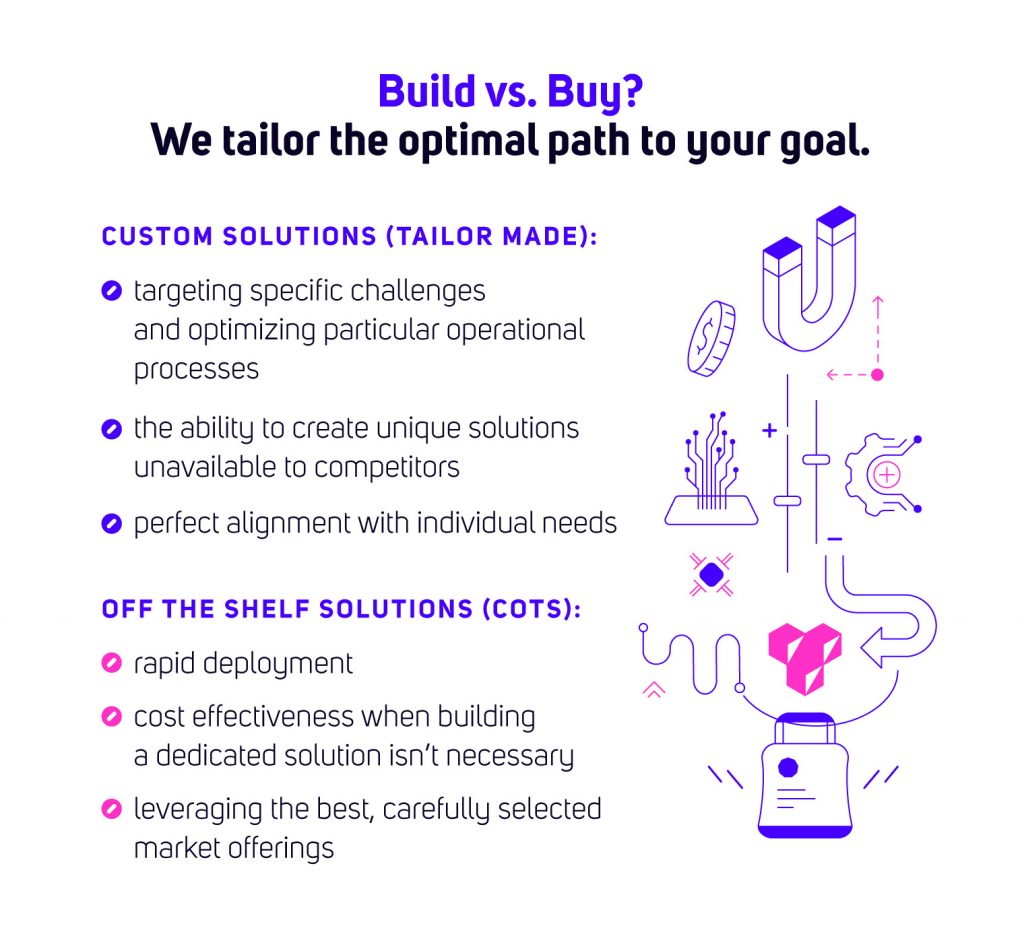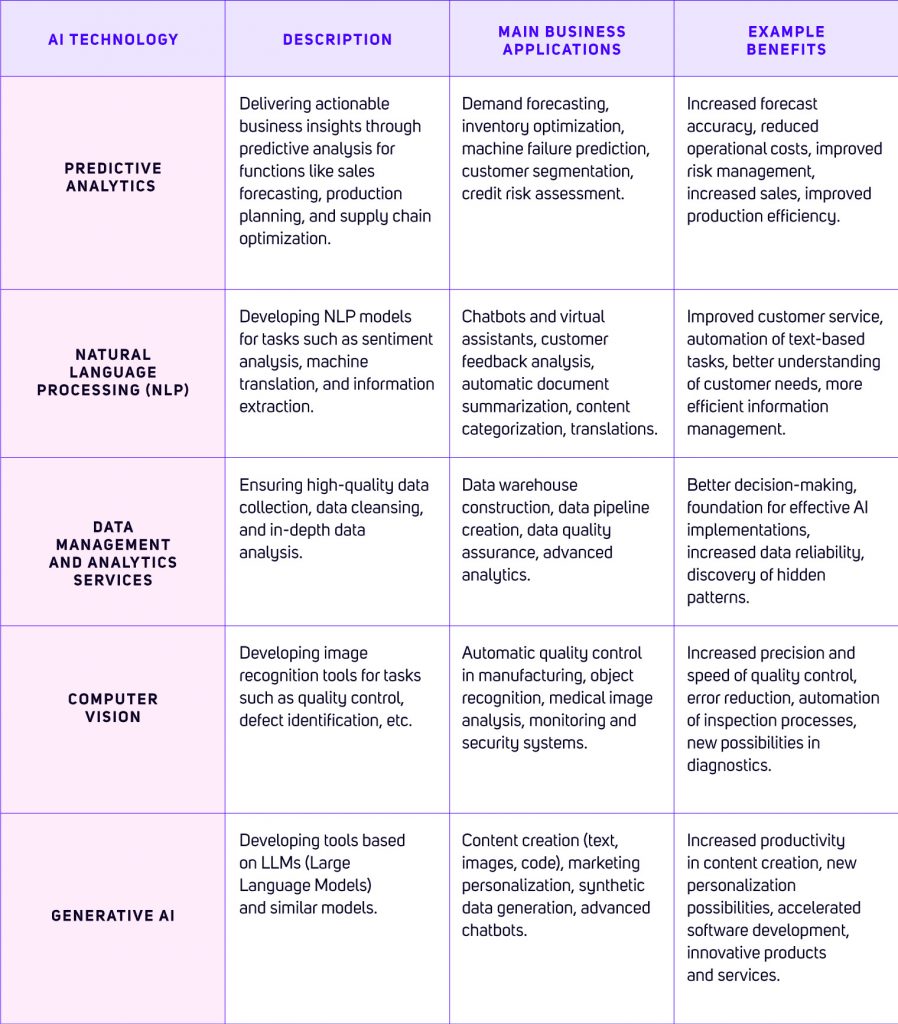AI in business – Not a Trend, but a Strategic Imperative
How do we guide an organisation through the entire AI journey? Our goal is to demonstrate that, when implemented thoughtfully and strategically, AI becomes a powerful tool in the hands of decision-makers – capable of delivering measurable value and building sustainable competitive advantage. We navigate through key phases: from initial exploration and awareness-building, through concept validation and development, to implementation, maintenance, and responsible governance. Elevating AI from a “trend” to a “strategic imperative” highlights its fundamental importance to long-term success, encouraging leaders to view it not merely as a tool but as an integral component of achieving core business objectives.
Phase 1 – Consulting, Training, and AI Opportunity Exploration
Every successful AI initiative begins with solid foundations. The phase of consulting, training, and exploration is crucial to preparing an organisation for conscious and effective AI adoption. Here, ideas take shape, and business needs are precisely mapped to technological capabilities.
AI consulting serves as the first step. Expert advice helps internal stakeholders identify specific areas where AI can bring the most value. The analysis includes an understanding of current challenges, strategic goals, and operational context. This is not merely a technical assessment but a deep dive into business realities to ensure that AI solutions are relevant and effective. 
Equally important is AI training. Developing internal teams’ competencies and building “AI literacy” across the organisation is essential so employees at all levels can identify AI opportunities and actively participate in projects.
This involves cultivating a culture where AI is seen as a supportive tool rather than a replacement for human work. Such a human-centred approach from the outset helps minimise risks of failure linked to a lack of understanding or acceptance.
Another key element is building a business case for specific AI initiatives. A compelling justification that clearly defines objectives, potential ROI, risks, and required resources is vital for securing buy-in and funding. This step reduces risk and ensures that AI efforts align tightly with strategic goals, avoiding technology-for-technology’s-sake scenarios.
Finally, realising business benefits – measuring and communicating the actual outcomes of AI implementations – is crucial. Establishing feedback loops to assess whether results meet expectations adds immense value. Success in one project, clearly demonstrated and shared, can create momentum and internal support for broader AI adoption.
This phase often leads to the initial exploration of specific technologies – such as predictive analytics for sales forecasting or natural language processing to enhance customer service.
Phase 2 – Proof of Concept and Testing
After identifying potential AI applications and developing a strong business case, the next phase is validation and innovation. This is the bridge between idea and full-scale implementation – focused on reducing risk and practically validating assumptions through a Proof of Concept (PoC). 
Developing a PoC means building a prototype for a specific, well-defined use case. The aim is to assess whether a given AI concept can deliver the expected value in practice. These are often small-scale experiments focused on key functionalities, designed to quickly answer questions about feasibility and business potential.
Often this phase is supported by an Innovation Lab, which tests new AI technologies, pilots innovative solutions, and fosters a culture of innovation within the organisation. It enables more exploratory work with cutting-edge developments in AI.
From idea to value. Our Innovation Lab is the bridge between strategy and full-scale deployment, reducing risk and maximising the chance of success.
The knowledge gained from the PoC – such as data requirements, algorithm performance, and user feedback – is invaluable. It ensures that the next stage – Development and Implementation – is built on solid, validated foundations, significantly improving the likelihood of success.
Phase 3 – Development and Implementation of AI Solutions
Once a concept has been successfully validated, it’s time to transform promising prototypes into operational AI solutions. This phase is where theoretical potential materialises into real-world tools delivering measurable business benefits.
A key task is the development of bespoke AI tools – building tailored models and applications that address specific challenges or optimise particular business processes. This enables the creation of unique solutions that meet a company’s individual needs. 
However, not all solutions need to be built from scratch. Selecting and integrating the best Commercial Off-The-Shelf (COTS) AI solutions ensures faster and more cost-effective deployment when bespoke development isn’t necessary. Regardless of the chosen path, Data Management and Analytics Services play a crucial supporting role. High-quality data collection, cleansing, and the creation of robust data pipelines are essential for effective AI performance. AI systems are only as good as the data they are built and operated on.
Phase 4 – Technical Support and Maintenance of AI Systems
Implementing AI solutions is not the end, but the beginning of their lifecycle. Like any advanced technology, AI systems require ongoing support and maintenance to continuously deliver expected value and perform optimally.
Support services include regular reviews, maintenance, updates, and fast response to issues. This is especially important given phenomena like model drift, where a model’s performance degrades over time due to changes in input data or evolving business environments. Continuous monitoring and retraining may be required.
Providing long-term support signals a commitment to partnership, not just one-off delivery.
Phase 5 – Ethics, Security and AI Project Governance
Deploying AI involves significant challenges around responsibility, ethics, and safety. This phase is essential and overarching – ensuring responsible, secure, and effective AI use. It should be addressed throughout the AI lifecycle.
A central component is AI Ethics & Governance – delivering guidance on ethical implications, regulatory compliance, privacy, and security. Key priorities include mitigating algorithmic bias, ensuring transparency, and assigning accountability for AI-driven decisions. Addressing these builds trust with clients and end-users alike.
The second pillar is AI Project Management – guiding projects from concept to successful deployment, ensuring effective resource use and goal delivery. AI projects are complex, involving multiple stakeholders, evolving technologies, and shifting requirements. Professional project management helps navigate this complexity.
Robust governance and ethical considerations also mitigate legal, reputational, and operational risks. This forward-looking approach futureproofs solutions against evolving regulations like the EU AI Act.
Which Areas Could Benefit Your Business?
After examining the phases of the AI service lifecycle, it is worth exploring the core AI technologies that underpin these services and drive transformation. Below are key AI domains with example business applications and benefits: 
These technologies rarely operate in isolation. Their synergy creates more powerful, integrated solutions. For instance, an advanced customer service chatbot might use NLP to understand queries, Generative AI to craft responses, and Predictive Analytics to anticipate needs.
Your AI Success Journey
This journey – from initial consultation and strategy (Phase 1), through concept validation (Phase 2), development and implementation (Phase 3), to support (Phase 4) and responsible governance (Phase 5) – shows that success in AI is the result of a structured, thoughtful process. It is not a random set of tools or technologies but a methodical approach that enables companies to turn vision into value.
Is your company ready to explore how these AI services can be tailored to your business landscape and strategic goals? The journey from vision to value starts with a conversation. Contact us!





